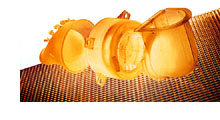|
Xerox
|
Stereolithography makes a strategic difference at Xerox by helping designers
muffle copier noise. With its SLA 250 and SLA 500, Xerox works within budget
and on schedule more easily and efficiently, consistently meeting design objectives.
"Because of stereolithography, our future products at Xerox will be of higher quality and lower cost."
- Rob Kendall, Model Maker
Rapid Prototyping Lab
Xerox Corp
|

|
The Challenge
What do cars and copiers have in common? Why, mufflers, of course! Design engineers of both automobiles and copy machines need to integrate muffler/cleaner assemblies into their products. You create noise when you drive down the road and when you run three copies of your memo.
To reduce this copier noise, air turbulence must be controlled. This was a core objective for Rob Kendall, model maker in Xerox's rapid prototyping lab. Stereolithography (SL) was key to rapid prototype generation of their new copier's muffler assembly design.
The Results
 To simulate sectioning of production parts from the silicone mold process,
the center muffler component was built in two pieces using stereolithography,
then bonded together with SL resin.
To simulate sectioning of production parts from the silicone mold process,
the center muffler component was built in two pieces using stereolithography,
then bonded together with SL resin.
This project exemplifies how SL lends itself to fast multiple iterations for design optimization. A third assembly component destined to hold a charcoal ozone filter was also constructed in the SLA (shown in far right of photo). The design shown was later modified to incorporate an air duct and then rebuilt on the SLA.
The final designs for each of these components were built using SL as patterns for silicone molding. This process allowed Xerox to create the optimal design comfortably within budget and schedule constraints.
Xerox has found that stereolithography boosts their competitive position in a number of areas:
- Confirms manufacturability of assemblies
- Fast, easy, low cost method for testing new, innovative design ideas
Saves money by form and fit testing to confirm assembles before investing in costly tooling
Quick turnaround on multiple copies of patterns for silicone molding
Provides aid in vendor relations, insuring a bid on the exact design
SLA parts are utilized in functioning copiers until production parts become available
The Process
The design drawings originated from a Xerox project group, which used Intergraph wireframes to represent the assembly. The files were sent to the rapid prototyping lab where the wire-frame reference file was converted to solids using Intergraph's Engineering Modeling System (EMS).
Rob took advantage of the unique features of the SLA 250 and SLA 500 to produce the required muffler assembly prototypes. A large portion of the assembly was constructed on the SLA 500 in Cibatool SL 5154 resin. Using the SLA 250 with Cibatool SL 5149 resin, an interior feature was constructed for insertion into the larger piece. While Rob was cleaning the SLA 500 part, the smaller piece was built in one hour in the SLA 250. The parts were then joined using SL resin as the bonding agent. "It proves the versatility of both machines working together.
As model maker in the rapid prototyping lab, Rob is responsible for turn-around time, cost and quality of parts produced on the SLAs. Turnaround from CAD file to finished part is typically one week.
The Tools
- CAD files from Intergraph Version 2.1.1
- SLA 500 with SL 5154 resin
- SLA 250 with SL 5149 resin
Company Profile
Xerox purchased their first SLA in 1990, after winning the 1989 Malcolm Baldrige National Quality Award. Today, they have both the original SLA 250 and an SLA 500.
Xerox Corporation is a global enterprise which develops, manufactures, markets, services and finances a complete range of products and services designed to make offices more productive. Xerox copiers, duplicators, digital production publishers, electronic printers, facsimile prod-ucts, scanners, workstations, networks, computer software and supplies are marketed in over 130 countries.
|



